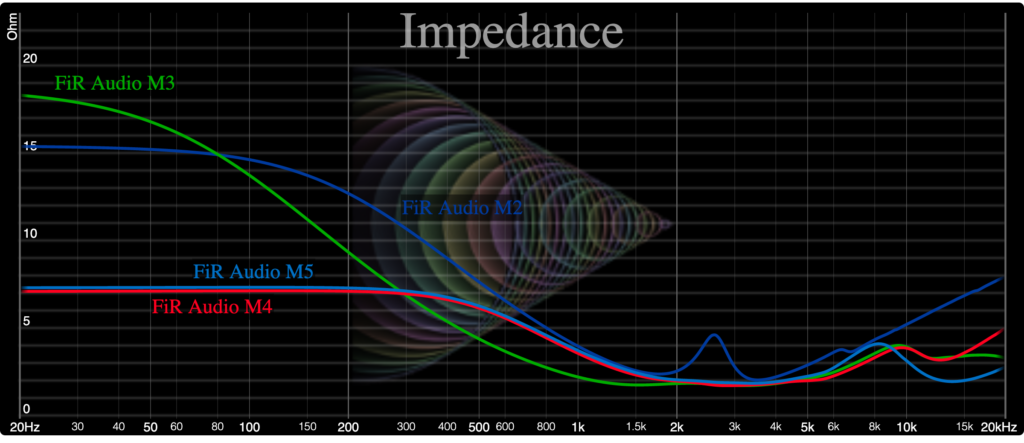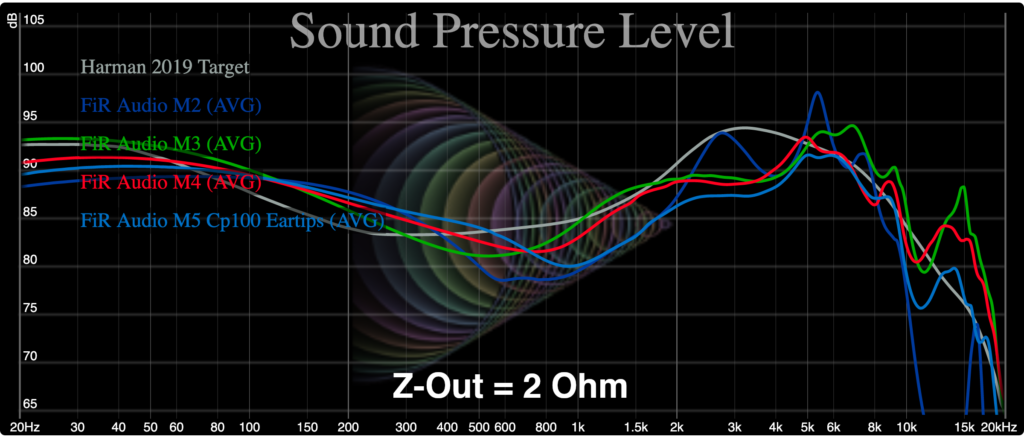FiR Audio M-Series miniHype

We’d like to acknowledge the loan of these four IEMs through the AudioTiers tour arranged with FiR Audio.
Since these IEMs all share the same exterior shell, we can cover the fit and seal issues for all four simultaneously. These IEMs are not that large, and while they’re not perfectly-contoured replicas of a concha bowl, most people shouldn’t struggle to get a good fit and seal with these. Their nozzles are fairly wide, to the point that foam and silicone eartips don’t sound dramatically different. We like SpinFit Cp100 eartips for their comfort and durability, so most of our listening and measurement tests were done with Cp100 tips.
All four M-series IEMs (M2, M3, M4 & M5) are relatively easy to drive, which adds to the puzzle of why all four tour units were supplied with balanced cables (2.5 mm for the M2, M3 and M5, and 4.4 mm for the M4). As we explain below, balanced cables are probably not the best idea for these IEMs.
The M2
The M2’s primary role in life appears to be as wingman, making the other FIR IEMs sound even more fantastic by comparison. The M2 has a nasty 5 kHz spike, too much mid-bass and a rolled-off sub-bass. To our ears, it sounds cheap; we’ve heard better-sounding IEMs for way less money. We can’t recommend it, and that’s all we’ll say about the M2. From here on out, however, it’s (mostly) all good news.
The M3, M4 & M5
Wow! All of these IEMs are simply fantastic and, depending on hearing and preference, all three could be contenders for the best-sounding IEM in existence right now. That’s not hyperbole. Quite possibly the best IEMs we’ve ever heard.
The sound differences are basically as follows. M3 is the more fun-sounding IEM. Its frequency response is a little v-shaped. That’s awesome and exciting, but sometimes even a little excess treble can be too much for extended listening periods. The M4 and M5 have fairly similar FR profiles to one another, following the Harman target more closely than the M3 in the treble. The differences between the M4 and the M5 are sufficiently small that they could easily be out-shadowed by variance due to manufacturing tolerance or effects of source output impedance. This is the achilles heel of these FiR IEMs. To sell an M4 and an M5 that have an FR this similar, manufacturing tolerances ought to at least be smaller than these variations and modest levels of source output impedance shouldn’t make a significant difference to the sound. We’ve now measured multiple M5 units and the variations were larger than the differences we see here between the M4 and M5 tour units. This is a problem for the consumer. What sound are you going to get if you buy an M5? To some extent you’re rolling the dice.
Now let’s consider those balanced cables. This is the impedance of the M2, M3, M4 and M5:

Their impedances are not only low, but they also have strong variations with frequency. This causes significant changes in FR, even with fairly small levels of output impedance (z-out). Here are the frequency responses measured from a near-zero Ohm z-out source and from a ~2 Ohm z-out source:


The result is two quite different-sounding sets of headphones. Interestingly, the M3 improves and sounds amazing with a 2 Ohm z-out, but it seems unwise to rely on two wrongs making a right. (What if you subsequently upgraded your source?) With increasing z-out, the M4 and, in particular, M5 deteriorate and become much darker-sounding. The problem with the supplied balanced cables is that, as of early 2021, most balanced-output source devices have at least a 2 Ohm output impedance.
With a close-to-zero Ohm z-out, we would rank these three headphones (from best to worst) as M5, M4 and then M3. With a 2 Ohm z-out, this situation is essentially reversed and the Harman ranking score backs this up. Given the wild impedance curves of these headphones, supplying them with balanced cables seems to have been a bad idea. None of these IEMs need the additional power from a balanced output. While balanced outputs can lower stereo cross-talk, this is entirely marketing hype as stereo cross-talk from all current single-ended source outputs is low enough to be inaudible to begin with. If you want to hear the M4 and M5 IEMs at their best, you need a very low z-out source, which, given the current situation in the DAP market, almost certainly requires a single-ended output.
With a low output-impedance source, our M5 unit has just a little less of that 5 kHz treble peak and fractionally edges out the M4. However, it’s a close call, and given all the caveats above, and individual hearing preferences and variations, the M3, M4 and M5 are all worthy of serious consideration. All three are up there amongst the very best headphones we’ve ever heard.
If you’d like to see any of these M-series IEMs compared with other high-quality IEMs, or to examine the effects of eartips or output impedance, etc., go crazy with the interactive graphtool below…
—————————————————
Did You Know?
All products on our databases come with a ‘microHype’ – brief subjective thoughts and impressions on the product and its ranking. To access the DAP microHypes, simply click on the slide for that DAP. To access the microHype for a headphone, click on the name of the heaphone once displayed, or click on the (red) score in any rank/search result. Certain products that are regarded as special, or particularly relevant or interesting, have more extensive reviews in the form of ‘miniHypes’. The latest miniHype is always displayed on HypetheSonic’s front page, with archived miniHypes shown below.
